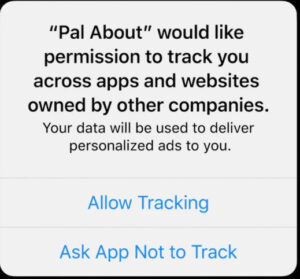How iOS 14 Will Impact Facebook Advertising and Your Top 5 Action Items
Let’s face it, there’s been a lot of panic and ruffled feathers about the upcoming App Tracking Transparency (ATT) changes that Apple will roll out in “early Spring 2021”. First and foremost, there is no need to panic! This post explains the changes in simple terms and ends with 5 top action items to be prepared.

While Apple had originally planned to roll the IDFA changes out in Fall 2020, they delayed it to Spring 2021 to allow developers and businesses more time to prepare. The changes will affect all mobile apps and therefore not just the Facebook advertising platform. Platforms such as Snap, Pinterest, Twitter, TikTok, LinkedIn will also be affected to varying degrees. However, I am covering the impact to Facebook/Instagram advertisers in this post because it’s the most widely-used advertising platform.
Let’s recap in simple terms what the changes actually are.
1. Apple users will get a notice for all apps allowing them to opt out of in-app ad tracking. The notice will look something like the below (provided by Apple).

2. This means that every app will have to ask you up front whether it is ok for them to share your IDFA with third parties including networks or data brokers
3. People that opt out will no longer be trackable on mobile apps or the mobile web
In response to this, here are the top changes Facebook has made/will make to its Ads Manager.
1. Advertisers can only track up to 8 conversion events (or 4 if they are value-based events) and prioritize them by importance. Only the top priority conversion event will be recorded for opted-out users
2. Conversion event data from opted-out users will be aggregated and delayed by 24-72 hours
3. The default conversion window changed on January 19th from 28-day click and 1-day view to 7-day click and 1-day view
4. Opted-out users can not be added to custom audiences. This means advertisers will not be able to retarget these users or add them to exclusion audiences
5. Advertisers will not be able to see age, gender, location, placement data for opted out users
What Facebook Advertising features will these changes affect?
1. Optimization of campaigns based off conversion events will become less effective as there will be gaps in the data as opted-out user activity is lost
2. Lookalike, interest, behavior, demographic, location audience targeting will all become less effective due to the loss of a large chunk of trackable users
3. Daily analysis of campaigns will be very inaccurate due to the Aggregated Event Measurement (AEM) which delays reporting by up to 3 days
This degradation of performance will happen over the long run as people start opting out of tracking and the severity of it will, of course, depend on how many people opt out. How many people will opt out of tracking? Of course, we can only speculate, but it is predicted that a large percentage of users will opt out.
What should advertisers do to prepare?
1. Export and save the data you have, slice and dice it and get a deep understanding of what percentage of your web traffic is coming from iOS so you can measure the impact of the changes when they roll out.
2. Use this data analysis to determine what percentage of your conversions happen after the 7-day click window. This will give you a number (multiplier) which you can apply to your 7-day click conversion metrics. Depending on your business, this multiplier could be very small and insignificant or it could have a big impact on your numbers.
3. Implement Conversion API (CAPI) via Shopify or manually with Google Tag Manager. This will help you track actions completed on your website through other means than pixel events.
4. Decide which 8 events (or 4 if you’re using value-based) for conversions you’ll track. Then prioritize them in the Events Manager. Bear in mind, only the top priority event will be recorded for opted-out users
5. Verify your domains. This will ensure you’re set up and “official” to Facebook.
Contact me if you need help navigating these changes!
